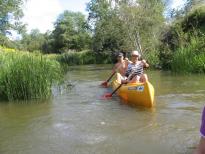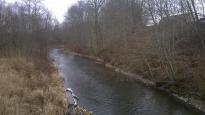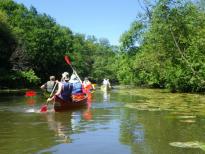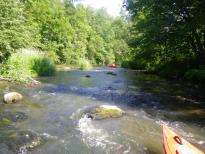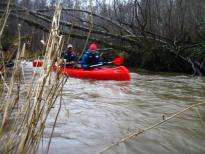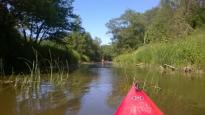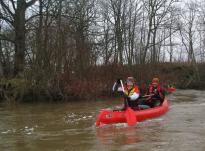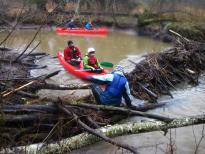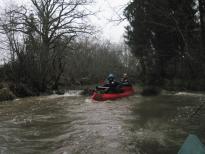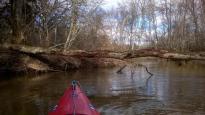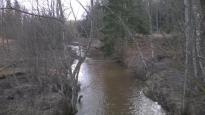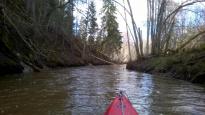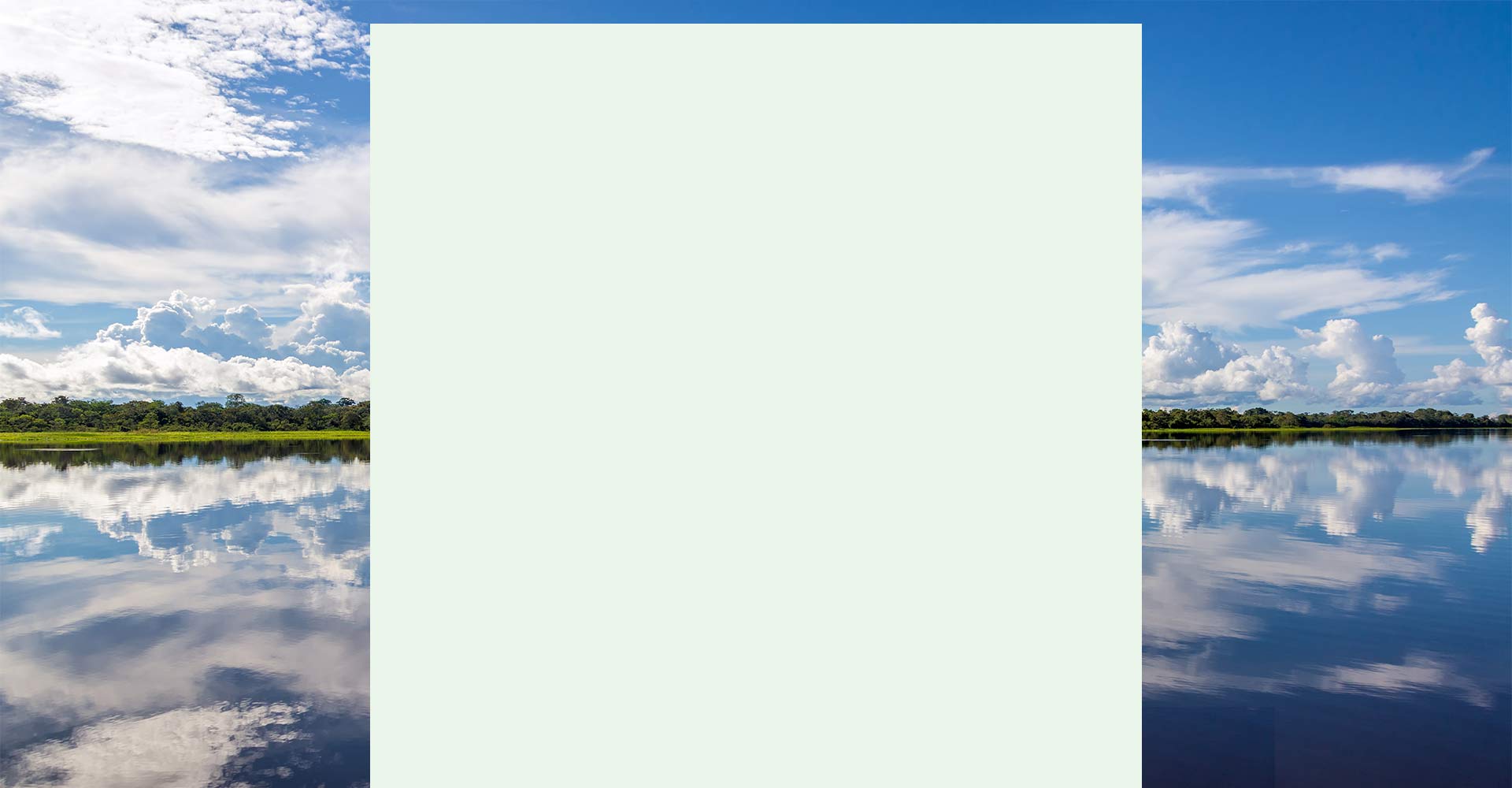
Tebra river route download for mobile devices (android/iphone)
The Tebra River has long been a lively transport artery. Along it in the barges from Saka port were supplied goods for Aizpute knights’ castle, floated trees, but on relationship of this neighbourhood with Gauja’s Livs is evidenced by place names: Turaidas, Orgas and Lankas. Early 20th century Tebra flow was regulated by 3 impressive water mill, the only one of which is preserved in Aizpute.
Until the Soviet occupation around Tebra always sparkled the life. Lower course of the Tebra during Soviet times was included in the closed border zone and the river was completely forgotten. It is overgrown, there formed conggestions of trees making obstacles for the flow. The situation changed rapidly around 2000 when Tebra rediscovered by water tourists.
Currently the Tebra is one of the favourite paddling rivers in western Kurzeme. Traditionally the paddling along the Tebra starts at Apriķi near the bridge over Alokste (C). Here is a convenient place where to get in the canoes. Tebra meets with Alokste after rapid, shallow and winding 600 meters where everyone can refresh their paddling skills and working in tandem. At the confluence the river becomes a significantly calmer and deeper, it gives enough time of relaxation before the next rapids. On its banks are growing majestic oaks and among their foliage the tower of Apriķi church can be seen.
Behind Apriķi the river winds through forests and pastures, stream is sufficient for paddling in resting mode. During the second half od summer in this section appears rush groves. They do not interfere paddlers, because in rush are formed peculiar “paths” – waterway in width of a paddling boat. Construction step by step is ending and after about 7 km from Apriķi starts a section what is called by paddlers as “Dinosaur Park”. Large and crooked trees bent over the stream form a dark shade, here are unexpectedly large individual stones, faded trunks of dead-wood and can be heard unsatisfied cry of osprey - at this section it cannot be overlooked even by the most inattentive paddler. “There was a feeling like a dinosaur will soon run over the river” – this was said by one experienced paddler.
Behind the “Dinosaur Park” the Tebra literally captures paddlers in trap of one and a half kilometre length. Flow of the river stops, it tries to flow through the swamp. Rushes, orchard grass and gray alder create a clear association with the Florida swamps, only instead of alligators here the beavers are reigning. At this section you should paddle harder and have to deal with it, because at the end the reward if waiting for you – after wide ninety-degree left bend the landscape changes completely and the river reaches mighty fir forest. Here the fastest section of the Tebra begins - about 2 km long cascade of continuous rapids and small dolomite falls. The most beautiful 14 km of the Tebra are paddled.
Than Tebra becomes calmer, but the flow does not end. Here again appear some separate hoses, also some rapids. Majestic forests are replaced by landscape of alder, cherry and spindle trees common for river banks in Latvia. This section is well suited for anglers - there are pits made by obsequent streams, pebble rapids and dark depths. Perch and chub catches are guaranteed. End of the section is marked by reinforced concrete bridge at the Tauriņi (Kalnenieki) house.
Behind the Tauriņi (Kalnenieki) bridge (E) the flow of the river completely ceases. Tebra has finished its run and now it calmly flows the last 7km to the confluence with the Durbe river through overgrown alder groves. It seems that the river has exhausted all its forces.
After confluence (G) with Durbe there is born new and 6.3 km short river - Saka. The landscape is changing, it is felt proximity to the sea. Old pile berths, distillery chimneys, nets and motorboats. Railway bridge, elegant staircase of the castle that in Upesmuiža park leads almost to the water (the castle was burned down in riots of 1905) and then is Pāvilosta. There remains paddling along the small fishing boats, a marina, and right there is already end of piers and the sea (G).
One of the most popular routes along the Tebra. Around Sarkanvalki the flow of the river stops and by looking on the river there arises a question - "In which direction does it flow?" After commencement of the paddling you have just enough time to make yourself comfortable in paddling boat, because very soon - after wide ninety-degree left bend the landscape changes completely and the river reaches mighty fir forest.
Soon, after wide ninety-degree left bend the landscape changes completely and the river reaches mighty fir forest. Here the fastest section of the Tebra begins - about 2 km long cascade of continuous rapids and small dolomite falls.
After the flow of the Tebra becomes calmer, but the flow does not end. Here again appear some separate hoses, also some rapids. Majestic forests are replaced by landscape of alder, cherry and spindle trees common for river banks in Latvia. This section is well suited for anglers - there are pits made by obsequent streams, pebble rapids and dark depths. Perch and chub catches are guaranteed. End of the section is marked by reinforced concrete bridge at the Tauriņi (Kalnenieki) house.
Fast section of river, cleaned within Estonia-Latvia programm project Riverways. You can canoe here only during high water season!
Traditional 2-days canoeing trip.
Behind Apriķi the river winds through forests and pastures, stream is sufficient for paddling in resting mode. During the second half od summer in this section appears rush groves. They do not interfere paddlers, because in rush are formed peculiar “paths” – waterway in width of a paddling boat. Construction step by step is ending and after about 7 km from Apriķi starts a section what is called by paddlers as “Dinosaur Park”. Large and crooked trees bent over the stream form a dark shade, here are unexpectedly large individual stones, faded trunks of dead-wood and can be heard unsatisfied cry of osprey - at this section it cannot be overlooked even by the most inattentive paddler. “There was a feeling like a dinosaur will soon run over the river” – this was said by one experienced paddler.
Behind the “Dinosaur Park” the Tebra literally captures paddlers in trap of one and a half kilometre length. Flow of the river stops, it tries to flow through the swamp. Rushes, orchard grass and gray alder create a clear association with the Florida swamps, only instead of alligators here the beavers are reigning. At this section you should paddle harder and have to deal with it, because at the end the reward if waiting for you – after wide ninety-degree left bend the landscape changes completely and the river reaches mighty fir forest. Here the fastest section of the Tebra begins - about 2 km long cascade of continuous rapids and small dolomite falls at the end of which is good landmark: rope bridge. The most beautiful 14 km of the Tebra are paddled.
Behind Akmeņakalni (D) the flow of the Tebra becomes calmer, but the flow does not end. Here again appear some separate hoses, also some rapids. Majestic forests are replaced by landscape of alder, cherry and spindle trees common for river banks in Latvia. This section is well suited for anglers - there are pits made by obsequent streams, pebble rapids and dark depths. Perch and chub catches are guaranteed. End of the section is marked by reinforced concrete bridge at the Tauriņi (Kalnenieki) house.
Behind the Tauriņi (Kalnenieki) bridge (E) the flow of the river completely ceases. Tebra has finished its run and now it calmly flows the last 7km to the confluence with the Durbe river through overgrown alder groves. It seems that the river has exhausted all its forces.
After confluence with Durbe there is born new and 6.3 km short river - Saka. The landscape is changing, it is felt proximity to the sea. Old pile berths, distillery chimneys, nets and motorboats. Railway bridge, elegant staircase of the castle that in Upesmuiža park leads almost to the water (the castle was burned down in riots of 1905) and then is Pāvilosta. There remains paddling along the small fishing boats, a marina, and right there is already end of piers and the sea.
One day trip till Pāvilosta.
Behind the Tauriņi (Kalnenieki) bridge (E) the flow of the river completely ceases. Tebra has finished its run and now it calmly flows the last 7km to the confluence with the Durbe river through overgrown alder groves. It seems that the river has exhausted all its forces.
After confluence (F) with Durbe there is born new and 6.3 km short river - Saka. The landscape is changing, it is felt proximity to the sea. Old pile berths, distillery chimneys, nets and motorboats. Railway bridge, elegant staircase of the castle that in Upesmuiža park leads almost to the water (the castle was burned down in riots of 1905) and then is Pāvilosta. There remains paddling along the small fishing boats, a marina, and right there is already end of piers and the sea.
One of the most popular routes along the Tebra. Around Sarkanvalki the flow of the river stops and by looking on the river there arises a question - "In which direction does it flow?" After commencement of the paddling you have just enough time to make yourself comfortable in paddling boat, because very soon - after wide ninety-degree left bend the landscape changes completely and the river reaches mighty fir forest.
Soon, after wide ninety-degree left bend the landscape changes completely and the river reaches mighty fir forest. Here the fastest section of the Tebra begins - about 2 km long cascade of continuous rapids and small dolomite falls.
After the flow of the Tebra becomes calmer, but the flow does not end. Here again appear some separate hoses, also some rapids. Majestic forests are replaced by landscape of alder, cherry and spindle trees common for river banks in Latvia. This section is well suited for anglers - there are pits made by obsequent streams, pebble rapids and dark depths. Perch and chub catches are guaranteed. End of the section is marked by reinforced concrete bridge at the Tauriņi (Kalnenieki) house.
Behind Apriķi the river winds through forests and pastures, stream is sufficient for paddling in resting mode. During the second half od summer in this section appears rush groves. They do not interfere paddlers, because in rush are formed peculiar “paths” – waterway in width of a paddling boat. Construction step by step is ending and after about 7 km from Apriķi starts a section what is called by paddlers as “Dinosaur Park”. Large and crooked trees bent over the stream form a dark shade, here are unexpectedly large individual stones, faded trunks of dead-wood and can be heard unsatisfied cry of osprey - at this section it cannot be overlooked even by the most inattentive paddler. “There was a feeling like a dinosaur will soon run over the river” – this was said by one experienced paddler.
Behind Apriķi (B) the river winds through forests and pastures, stream is sufficient for paddling in resting mode. During the second half od summer in this section appears rush groves. They do not interfere paddlers, because in rush are formed peculiar “paths” – waterway in width of a paddling boat. Construction step by step is ending and after about 7 km from Apriķi starts a section what is called by paddlers as “Dinosaur Park”. Large and crooked trees bent over the stream form a dark shade, here are unexpectedly large individual stones, faded trunks of dead-wood and can be heard unsatisfied cry of osprey - at this section it cannot be overlooked even by the most inattentive paddler. “There was a feeling like a dinosaur will soon run over the river” – this was said by one experienced paddler.
Behind the “Dinosaur Park” the Tebra literally captures paddlers in trap of one and a half kilometre length. Flow of the river stops, it tries to flow through the swamp. Rushes, orchard grass and gray alder create a clear association with the Florida swamps, only instead of alligators here the beavers are reigning. At this section you should paddle harder and have to deal with it, because at the end the reward if waiting for you – after wide ninety-degree left bend the landscape changes completely and the river reaches mighty fir forest. Here the fastest section of the Tebra begins - about 2 km long cascade of continuous rapids and small dolomite falls. The most beautiful 14 km of the Tebra are paddled.
 Dzintare Castle Mound
Dzintare Castle Mound
 Resting area "Sarkanvalki"
Resting area "Sarkanvalki"
 Resting area "Lejas"
Resting area "Lejas"
 Ruins of bridge
Ruins of bridge
 Tebras Zebra
Tebras Zebra
 Saļiena mills ruins
Saļiena mills ruins
 Resting area Rasaiņi
Resting area Rasaiņi
 Resting area Stembre
Resting area Stembre
 Pedestrian bridge
Pedestrian bridge
 Resting area Saka
Resting area Saka
 Camping "Ievlejas"
Camping "Ievlejas"
 Resting area "Kraujiņas"
Resting area "Kraujiņas"
 Sakasleja Evangelic Lutheran Church
Sakasleja Evangelic Lutheran Church

(+371) 26426992

